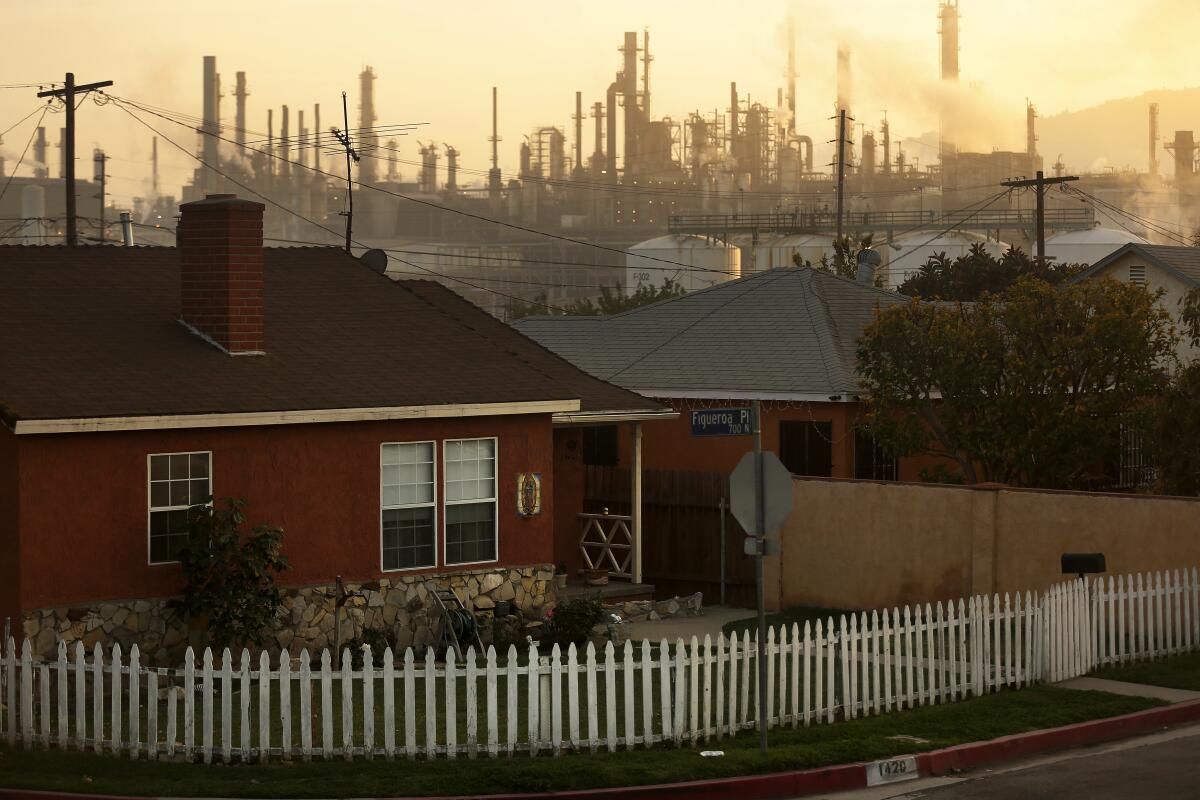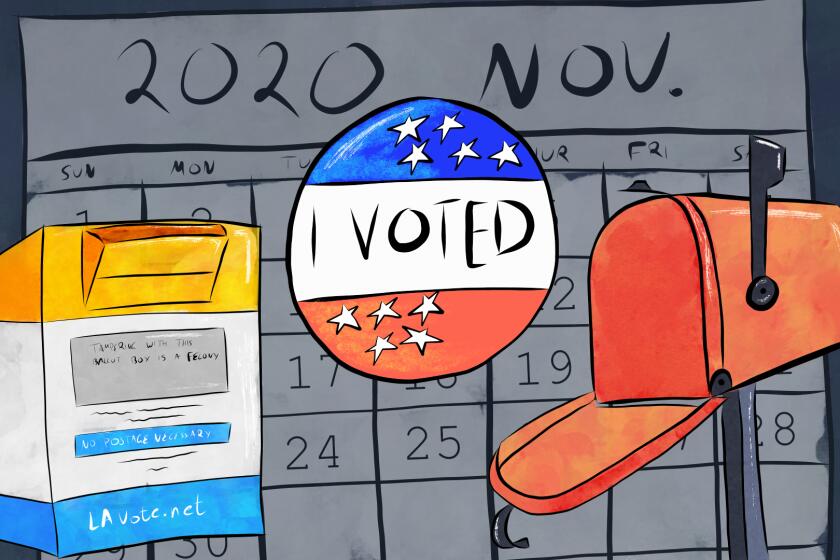California officials see boon in Biden’s climate plan

- Share via
WASHINGTON — Even as California aspires to a more sustainable, climate-friendly economy, the environmental degradation Bahram Fazeli witnesses daily is an unwelcome reminder of how much the state is held back by a federal government pushing in the other direction.
The oil wells, refineries, metal-finishing businesses and hazardous waste facilities in Wilmington and Huntington Park, where the environmental activist works, leave residents of those primarily Latino communities acutely exposed to health risks. Fazeli has lost patience with the pace of change.
“There needs to be a transformative vision that essentially commits to significant investment in phasing out fossil fuels and creating good-paying jobs — what we call a just transition,” said Fazeli, who works for a group called Communities for a Better Environment.
The feeling is shared widely in California, where out-of-control wildfires this fall have added to a sense of urgency about combating global warming.
That urgency gives the state a particularly large stake in the outcome of an election that poses a drastic contrast on climate issues — a White House steeped in climate denial and closely allied with fossil fuel companies versus a Democratic candidate who has embraced a $2-trillion climate plan that would rely heavily on California innovation and ambition as a template for fighting global warming across the country.
The Trump administration has spent billions of dollars in an almost entirely unsuccessful effort to prop up the nation’s coal industry and has given priority to coal and oil production over renewable sources. The administration’s policies have put the economic interests of regions heavily dependent on coal and oil production ahead of states like California.
Biden would largely reverse that. California’s senior elected officials — all Democrats — believe Biden’s election would unleash a flurry of initiatives in the state designed to reshape the energy and transportation sectors and shift money to low-income communities suffering the most from pollution caused by fossil fuels.
“It would be going from pushing a rock up a mountain to running downhill with the wind at your back,” said Jody Freeman, who was President Obama’s advisor on climate change and now directs the environmental law program at Harvard.
Under a Biden administration, the unending environmental litigation between California and Washington — more than 100 lawsuits to date — would give way to an infusion of federal cash to bring new technologies to scale.
Devices that suck greenhouse gases from the air, gigantic batteries that can store huge amounts of energy generated by wind and solar, and fleets of heavy-duty electric trucks are among the many innovations already in beta testing.
The biggest and most immediate impact would likely be felt in the auto industry — transportation accounts for more greenhouse gas emissions than any other sector of the economy.
The ambitious blueprint California set for shifting Americans into cleaner-burning and zero-emission cars and trucks has been torn up by the Trump administration, which is trying to revoke the long-standing legal authority for California to chart its own course on auto emissions.
Biden has pledged to reinstate those plans and make them more aggressive, expanding beyond passenger vehicles and SUVs into the most polluting trucks.
“It would be a big deal,” said Hannah Pitt, a senior analyst at the Rhodium Group, which tracks greenhouse gas emissions. “The fuel economy rollbacks are Trump’s biggest rollback to date.”
California has been trying to forge ahead with its own fuel-economy regulations in the face of White House hostility. If the federal government were to again apply the California standards nationally — as it did during the Obama era — that would set the nation on a path toward new cars and SUVs averaging 45 miles per gallon within six years, Pitts said.
“Think of us as guinea pigs,” said UCLA environmental law professor Ann Carlson. “If we succeed in cutting emissions, then the rest of the country follows suit. If we don’t, the pattern has been that it’s been much, much slower and harder for others.”
Get our L.A. Times Politics newsletter
The latest news, analysis and insights from our politics team.
You may occasionally receive promotional content from the Los Angeles Times.
The state’s electric-vehicle innovators would be in line for a significant boost under infrastructure spending plans pushed by Biden and leading Democrats in Congress. Some of the subsidies could come immediately, as Biden would likely end the freeze the Trump administration has imposed on $18 billion in loans Congress already authorized for advanced technology vehicle development.
Such loans could jump-start such projects as a “Lithium Valley” envisioned at the Salton Sea, said Matt Petersen, president of the Los Angeles Cleantech Incubator, a public-private partnership created to help the city meet its green transportation goals.
The Salton Sea effort would leverage the unique geography of the area for construction of geothermal electricity plants that would extract lithium from brine. The lithium would be used to manufacture batteries for electric cars.
“Access to lithium domestically is critical for the electric-vehicle sector,” Petersen said. “This loan program could help finance facilities that create a supply chain for the region.”
Renewal of a climate alliance between California and the White House would also enable the state to make strides building another key component for electric vehicles: charging stations. The state has 62,000 of them now, far short of the goal it has set for itself of 250,000 by 2025. It needs federal subsidies to get there.
The changes in the electricity sector could be even more dramatic.
“A Biden administration would mean everywhere would start to look like California in terms of investment in renewables,” said Michael Wara, director of the climate and energy policy program at Stanford Law School. “That would allow California to go even further. There would be a huge push in research and development perspective, and deployment.”
During the Obama era, the state, in partnership with the federal government, made plans to build solar mega-facilities for power companies that initially seemed a pipe dream. The state brought nine of them online.
Even after Trump stops hitting his favorite punching bag, California will feel the impact of his immigration restrictions.
“We were able to launch the utility-scale solar industry,” said Robert Weisenmiller, former chairman of the California Energy Commission. “Not just in California, but globally.”
“If we had the state and federal government working together again, rather than California trying to push and the federal government saying ‘no’ — if Washington put its foot on the accelerator and not the brake — it would be marvelous,” Weisenmiller said.
Advances would go beyond electricity production, he said, moving into the kind of efficiencies of lighting and home appliances that California pioneered during the Obama era, leading to major reductions in energy use. By contrast, the Trump administration has blocked new efficiency standards for light bulbs and pushed for increased water usage from shower heads.
At a National Academies of Sciences workshop Weisenmiller recently attended, scientists repeatedly spoke about new technologies being developed in California labs. Discussion turned to resilient “micro” power grids that could more nimbly deploy wind and solar energy, fuels made from seaweed and other renewable resources, and the construction of buildings with materials designed to absorb carbon.
The scientists emphasized the need to bring to scale carbon-capture technologies that suck greenhouse gases from the atmosphere and talked of breakthroughs that could make hydrogen-powered vehicles affordable.
Toward a more sustainable California
Get Boiling Point, our newsletter exploring climate change, energy and the environment, and become part of the conversation — and the solution.
You may occasionally receive promotional content from the Los Angeles Times.
Experts on clean energy believe at least some of those technologies are within reach after experiencing, during the Obama administration, the scale of progress that can happen when the federal government is invested.
One area where Democrats have grown considerably more ambitious than they were during Obama’s tenure is in spreading the benefits of these changes to the low-income and minority communities that have suffered most from fossil fuel pollution.
“This is the first time there’s ever been any real substance in a candidate’s plan” for addressing the damage pollution has caused marginalized communities, said Mustafa Santiago Ali, a former associate administrator in the Obama administration’s EPA environmental justice office.
Under Biden’s plan, such communities would receive 40% of “overall benefits of spending” by the federal government in areas such as clean energy and energy efficiency, green transportation and sustainable housing.
For Californians who live near freeways, oil refineries, rail yards and the ports of Los Angeles and Long Beach, a change in administration could change lifespans, Ali said.
“We know that about 100,000 people are dying prematurely every year from air pollution in our country, and that’s the low number,” he said. “The basic protections have not completed the mission — not even close.”
Environmental justice advocates remain wary, though, of indulging in too much optimism. Without steady pressure from activists, they said, the new economy Biden’s campaign is promising — one bolstered by jobs building electric cars and charging stations, retrofitting houses and strengthening the electric grid — could benefit major corporations and CEOs far more than ordinary Americans.
But a bigger threat, they say, is four more years of Trump, who has made clear he will work to stop any policies that threaten the fossil fuel industry.
The president’s antipathy for the state and its clean-energy agenda, Carlson suspects, would be even more pronounced in a second term.
“California leads the way in opposing his presidency,” she said. “I think he’ll take it out on us in ways we can’t imagine.”
More to Read
Get the L.A. Times Politics newsletter
Deeply reported insights into legislation, politics and policy from Sacramento, Washington and beyond. In your inbox twice per week.
You may occasionally receive promotional content from the Los Angeles Times.














